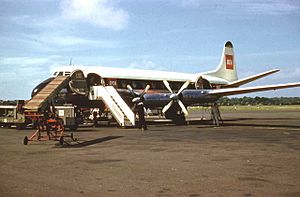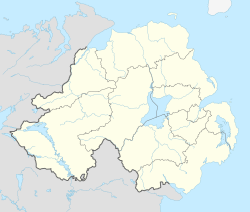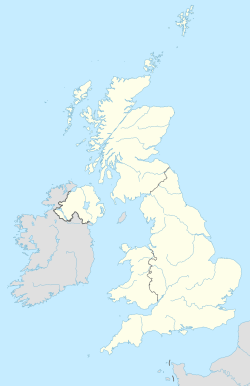RAF Nutts Corner facts for kids
Quick facts for kids RAF Nutts CornerHMS Pintail |
|||||||||||
|---|---|---|---|---|---|---|---|---|---|---|---|
| Crumlin, County Antrim in Northern Ireland | |||||||||||
|
Shown within Northern Ireland
|
|||||||||||
| Coordinates | 54°37′52″N 006°09′14″W / 54.63111°N 6.15389°W | ||||||||||
| Type | Royal Air Force Station | ||||||||||
| Site information | |||||||||||
| Owner | Air Ministry Admiralty |
||||||||||
| Operator | Royal Air Force Royal Navy |
||||||||||
| Controlled by | RAF Coastal Command Fleet Air Arm |
||||||||||
| Site history | |||||||||||
| Built | 1940 | ||||||||||
| In use | 1941-1946 | ||||||||||
| Battles/wars | European theatre of World War II | ||||||||||
| Airfield information | |||||||||||
| Elevation | 96 metres (315 ft) AMSL | ||||||||||
|
|||||||||||
Royal Air Force Nutts Corner, often called RAF Nutts Corner, was a special air base used by the Royal Air Force (RAF). It was located near Crumlin in County Antrim, Northern Ireland. This base played an important role during World War II.
Contents
RAF Nutts Corner During World War II
Work on the Nutts Corner airfield started in the summer of 1940, right in the middle of World War II. It was built very quickly because it was so important. The base officially opened on June 2, 1941.
One of the first squadrons to use it was No. 120 Squadron RAF, flying large Liberator planes. These planes were used for long patrols over the Atlantic Ocean. In January 1942, No. 220 Squadron RAF arrived with their Lockheed Hudson planes. They later switched to Fortress I bombers.
Nutts Corner became a key place for planes flying across the Atlantic Ocean. Many aircraft, especially B-17s, arrived here from the United States. Even though the RAF was in charge, American air forces also had a presence at the airfield. By the end of 1943, over 385 American planes had passed through Nutts Corner.
In July 1944, the airfield was very busy, with 372 planes arriving in just one month! However, most of these transatlantic flights soon started landing at Prestwick instead. By the end of 1944, fewer American planes were using Nutts Corner.
After the war ended, in July 1945, the Royal Navy took over the airfield and called it HMS Pintail. But it was given back to the RAF in April 1946.
Many different air units were based at Nutts Corner during the war. Some of these included:
- 4th Naval Fighter Wing
- No. 44 Squadron RAF
- No. 120 Squadron RAF
- No. 160 Squadron RAF
- No. 220 Squadron RAF
- No. 231 Squadron RAF
- 772 Naval Air Squadron
- 802 Naval Air Squadron
- 803 Naval Air Squadron
- 807 Naval Air Squadron
- 809 Naval Air Squadron
- 879 Naval Air Squadron
- 883 Naval Air Squadron
- 891 Naval Air Squadron
- 1835 Naval Air Squadron
- 1837 Naval Air Squadron
- 1852 Naval Air Squadron
- Training Units
- No. 104 (Transport) Operational Training Unit RAF (March 1943 - February 1944)
- No. 1332 (Transport) Heavy Conversion Unit RAF (October 1944 - April 1945)
- No. 1674 Heavy Conversion Unit RAF (February - March 1944)
From Military Base to Civilian Airport
After World War II, on December 1, 1946, Nutts Corner became a civilian airport. It was renamed Belfast-Nutts Corner Airport. This happened because the old Belfast Harbour Airport (now George Best Belfast City Airport) had shorter runways. Nutts Corner had longer runways, which were better for the larger planes being used. Also, the Belfast Harbour Airport didn't have much space to grow, and there were tall cranes nearby that could be dangerous for planes.
Nutts Corner was a good choice because it already had a lot of paved areas from its time as an RAF base. These hard surfaces were perfect for civilian aircraft.
However, by the late 1950s, Nutts Corner was no longer ideal for civilian flights. The airport was close to the Belfast mountains, which meant planes had to fly in at a steep angle. There were also obstacles like radio transmitters on the mountains. Another problem was that only one of Nutts Corner's three runways was suitable for modern aircraft.
Aldergrove Airport had two runways that were set at different angles. This made it easier for planes to land even if the wind changed direction. So, in July 1959, the decision was made to move civilian flights back to Aldergrove. The change became official in September 1963.

What is Nutts Corner Used for Today?
Today, part of the old airfield is used as a section of the A26 Moira Road. This road runs for about 2 kilometers on one of the former runways.
From 1984 to 2004, the airfield was used for exciting events like the Irish Superbike Championships and Rallycross races. However, these events were stopped due to noise complaints from people living nearby.
A small part of the circuit is still used by the Northern Ireland Carting Club (NICA) and the Ulster Karting Club for go-karting. The site also hosts a weekly market, and a model aircraft club uses a section of the area.
Notable Accidents and Incidents
Throughout its history, Nutts Corner experienced several aircraft accidents.
- On February 18, 1942, a Liberator bomber crashed shortly after taking off for an Atlantic patrol. Some crew members survived, but others did not.
- On August 21, 1942, Harry King Goode, a famous pilot from First World War, was killed during a demonstration flight in a Liberator plane.
- On March 27, 1951, a cargo plane crashed after taking off. The investigation found that ice in the engine's air intake was a likely cause. This accident resulted in the loss of lives.
- On January 5, 1953, Nutts Corner was the site of a very serious air accident in Ireland. A British European Airways (BEA) plane crashed while trying to land, hitting landing lights and a building. Many people on board lost their lives.
- On October 23, 1957, another BEA plane crashed at the airport, and all seven people on board died.
See also
- List of former Royal Air Force stations



